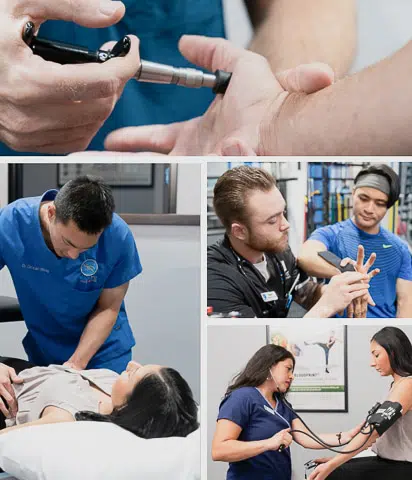TMD

Appointment Inquiries
Call us at: (877) 222-5348
Definition
Pain in and around the jaw joint and surrounding muscles.
Root Causes
Cartilage Damage, Erosition of the Articular Disk, Jaw Injury, Lack of Sleeo, Orthodontic Braces, Poor Diet, Poor Posture, Prolonged Stress
Risk Factors
Arthritis, Dental Procedures, Prolonged Mouth Opening, Structural Jaw Problems, Surgery with a Breathing Tube, Teeth Grinding
Treatments
Activator Method, Active Release Technique, Chiropractic, Myofascial Release Technique, Physical Therapy, Trigger Point Injections
What are the TMJ and TMD?
TMJ stands for the temporomandibular joint. This joint connects your jawbone (or mandible) to the temporal bones of your skull. There are two temporomandibular joints, one on each side of your head right in front of your ears. It is commonly called the jaw.
The upper part of your jawbone is called the condyle. When you open your mouth, the condyles slide along the joint socket at the base of your skull. When you close your mouth, they slide back into their original, resting position.
The temporomandibular joint is one of the most complicated joints in the body because it provides movement in all directions (up/down, left/right, and forward/backward). To keep this operation smoothly functioning, soft tissue lies between the condyles and the skull called an articular disc. These discs absorb shock to the joint from chewing and other mouth movements.
The terms temporomandibular joint (TMJ), temporomandibular disorder (TMD), temporomandibular joint disorder (TMJD) and temporomandibular joint syndrome are often used interchangeably. For accuracy, it’s best practice to use “TMJ” when discussing the joint and “TMD” or “TMJ syndrome” when discussing compromised movement and pain around the jaw joint and the muscles that control the jaw.
According to the National Institute of Dental and Craniofacial Research, around 10 million Americans suffer from TMD.
Symptoms of TMD (or TMJ syndrome)
Temporomandibular joint disorder (TMD) is myofascial pain and discomfort in the jaw. It also commonly includes difficulty chewing, as well as locking of the joint. Symptoms of TMJ disorders can appear on one or both sides of the jaw.
If you have TMD, you may also experience:
- Change in jaw alignment (how your upper and lower teeth align)
- Chronic facial or oral pain
- Clicking, popping, or grating in the jaw
- Limited jaw movement
- Ear pain or earache
- Ear popping
- Pain in your neck and shoulders
- Soreness in the temple muscles
- Stiffness or tenderness in the jaw muscles
- Toothache sensation
Your symptoms depend on the severity and cause of your condition. If there’s no pain and no limited movement associated with your jaw clicking, you probably don’t need treatment. TMD often goes away on its own after a few weeks or months.
If you are experiencing pain, difficulty moving your jaw, or the clicking is bothersome, TMD is very treatable.
Causes of TMD
In many cases, the cause of a patient’s TMJ disorder is not clear. You may have one of these or more of these causes or none of these and still be experiencing TMD.
Some common causes of TMJ disorders include:
- Cartilage damage due to arthritis
- Erosion of the articular disc
- Injury to the jaw, such as by an impact or blow
While scientific studies continue regarding TMD, some inconclusive but possible other causes include:
- Lack of sleep
- Orthodontic braces
- Poor diet
- Poor posture that strains the muscles of the neck and face
- Prolonged stress
Risk factors for TMD
While the cause of your TMD may be unclear, you may be at higher risk if you have or had any of the following:
- Arthritis
- Prolonged mouth opening
- Recent dental procedures
- Surgery where a breathing tube was used
- Structural jaw problem present at birth
- Teeth grinding, clenching, or gnashing (bruxism)
TMJ disorders affect women between the ages of 18 and 44 more often than other age groups and men.
Treatments for TMD
The best treatment for TMD is prevention. The best prevention is a reduction of overuse of the jaw muscles. You may try the following to reduce or eliminate TMD at home:
- Apply an ice pack or heat
- Avoid chewing gum
- Avoid singing too often and too loudly
- Avoid yawning overly wide
- Eat soft foods
Most TMD is temporary and will resolve on its own. You should seek medical attention if your pain or tenderness is persistent (occurs all the time) or if you can’t open and close your jaw completely. A medical doctor, chiropractor, dentist, and other specialists can diagnose TMD and discuss possible causes and treatment plans.
At BackFit, your first visit for TMD will include a consultation, medical health information history, and an exam with one of our Doctors of Chiropractic. Digital x-rays in-house or other imaging such as MRI (magnetic resonance imaging) or CT scan may also be ordered to eliminate other possible conditions. Most TMJ conditions respond very well to chiropractic treatments, especially the gentle activator method.
Our chiropractors can also help alleviate your TMD with active release therapy used to break down scar tissue, as well as Myofascial Release which works to relax muscles and other soft tissue. Doctors of Chiropractic are also licensed to recommend lifestyle modifications such as relaxation techniques to reduce stress.
Physical therapy in-house can also prescribe stretching and strengthening techniques and modalities to help relax the muscles around the jaw. Trigger point injections and anti-inflammatories from our medical team can also relieve jaw pain to assist in the healing process.
More About BackFit
Looking to learn more? Explore our locations, treatments, or our new patient offer below or contact one of the BackFit Family of staff to have your questions answered.


